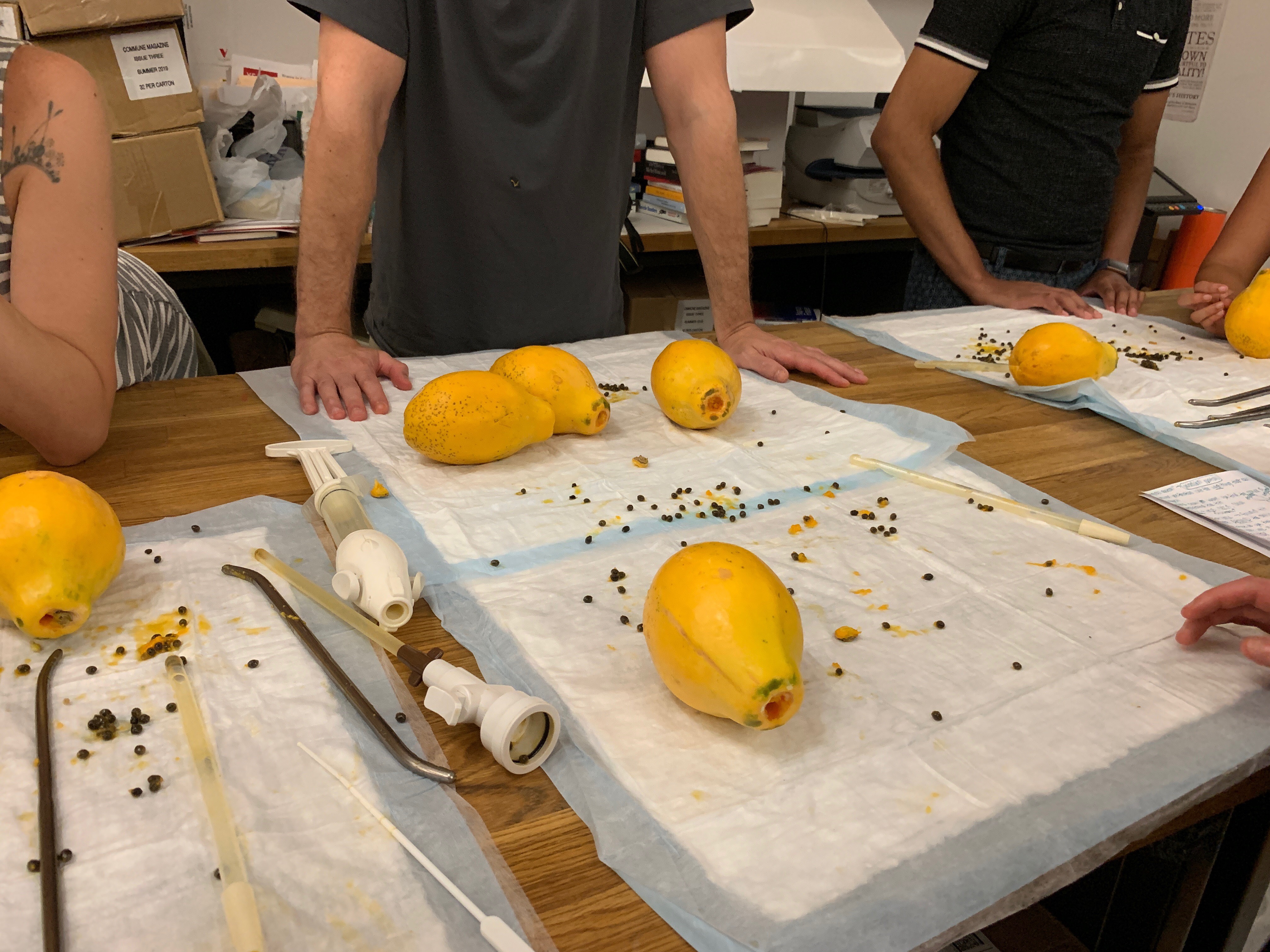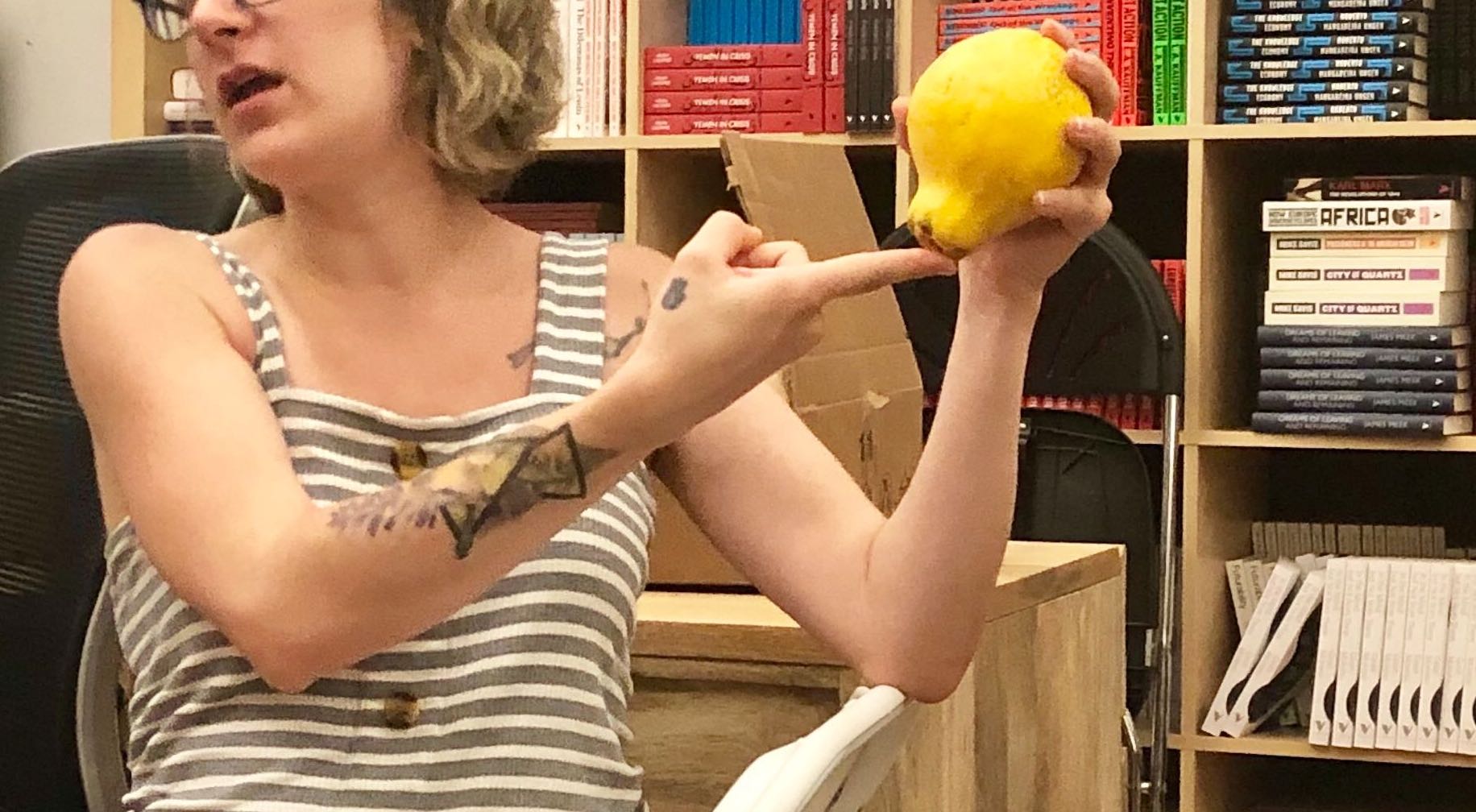“This is a 10-week gravid uterus,” Zoey Thill said, holding up a "pregnant" papaya the size of a large fist. “And this,” she added, gesturing to her own pregnant belly, “is a 38-week gravid uterus.”
Thill, a New York City-based abortion provider, was explaining the anatomy of the uterus to a group of about a dozen of us, in Verso Books’ Brooklyn office on a Monday night. The narrow part of the papaya, where the stem would be, is like the cervix, she said. The broader portion of the papaya is like the upper area of the uterus known as the fundus—and it's that part we would want to avoid puncturing with our tools when, in just a few minutes, we would practice performing an aspiration abortion on our own papayas.
But if we did by accident, that was OK, Thill said. “We’re not going to shame perforators,” she reassured.
Thill brought us to a long table across the room, where several Hawaiian papayas were lined up on surgical pads. After telling us about the tools that were laid out—plus the ones she didn’t have with her, the speculum and tenaculum—Thill demonstrated a first-trimester abortion on the papaya she’d displayed earlier. She talked to the “patient” throughout, checking in on how they were doing as she inserted a finger into the “cervix,” then pantomimed inserting the speculum; she pretended to apply the local anesthetic and then began inserting the metal tapered rods on the table one by one to dilate the opening.
When the papaya was fully “dilated,” she placed a plastic tube called a cannula inside and attached it to a manual vacuum aspirator, a plastic, syringe-like device, sucking out the inner contents of the papaya: what, for our purposes, was the pregnancy. From start to finish, the procedure had taken no more than three minutes.
Thill admired the seeds in the plastic tube. “This is a really fucking good one.”
Then it was our turn. We partnered up, holding the papayas for each other as we repeated what she had just shown us. I felt slightly nervous, even though I knew I was only practicing on a fruit, not a person. Thill held the papaya for me and after I dilated it, she reminded me how to attach the aspirator to the cannula. I clamped down the two small locks on the end of the instrument, pulled the handle toward me to create suction, and eased it gently onto the plastic tube—I wasn’t going to be the one to perforate my papaya’s fundus.
In one smooth motion, I rotated the aspirator, drawing out dozens of seeds, surprised and pleased to see that my amateur skills could produce the same result. Next to me, others were doing the same, rejoicing with every successful extraction. “Yes!” they exclaimed each time.
“It’s even more satisfying when it’s a real abortion,” Thill said.

Papaya workshops like the one Thill hosted are nothing new. They date back to 2005, when two professors from the University of California, San Francisco published a paper showing that, because of its size and composition, a papaya could serve as a “simulation model” for training in a first-trimester abortion procedure known as manual vacuum aspiration, or MVA. Reproductive Health Access Project (RHAP) used the research to design a comprehensive papaya training for medical students, nurses, and doctors to teach them to provide the procedure in a clinical setting. About five years ago, RHAP began offering the workshops to non-clinical audiences, and have hosted hundreds since.
As threats to Roe v. Wade escalate, the workshops have been getting more attention, and finding wider audiences. Earlier this month, former New Jersey abortion clinic director Jen Moore Conrow and Abortion Access Front founder Lizz Winstead demonstrated an abortion on a watermelon (at the time, there’d been a salmonella outbreak among papayas) at the annual progressive political convention Netroots, to an audience of around 100 people. Winstead said she had been to several RHAP workshops before, but this was her first in front of a group this large.
Lisa Maldonado, RHAP’s executive director, said over the last couple of years she’s noticed an upswing in the number of requests the organization has gotten to host papaya workshops. And more individual abortion providers like Thill, who learned how to provide abortions on papayas as medical students, have taken it upon themselves to develop similar workshops and trainings and open them up to the public. I’d found out about Thill’s on Facebook.
The point of papaya workshops isn’t necessarily to teach people how to perform an aspiration abortion at home. Thill said wanted to educate people about what an abortion procedure entails—information she believes shouldn’t belong only to doctors—to help combat fear, misinformation, and stigma. “I just want to be clear that when you leave here you won’t be competent at providing abortions, so don’t go fucking crazy,” Thill said by way of disclaimer.

Later, Thill told me she hopes to eventually host an event for people providing underground abortions; she just hasn’t found such a group of people yet. (Thill is less likely to find one in New York, where abortion rights were recently enshrined in state law.) But we know they exist: A 2018 story in California Sunday Magazine described a covert network of providers performing abortions outside the medical system. And in her new book Everything Below the Waist, Jennifer Block writes about attending a secret speculum insertion and papaya workshop taught by a clandestine provider who asked not to be identified for fear of being discovered by law enforcement.
Still, most organizations and doctors who host the workshops for laypeople say their primary aim is to demystify abortion, and change the way supporters of the procedure advocate for it.
“We see it as a strategy to start a really honest conversation about what abortion is and isn’t, and destigmatize it,” Maldonado said. “The papaya workshop helps us do that in a really concrete way, usually in a small group setting where we can answer whatever questions people have.”
Thill focused some of the night’s discussion on language: Instead of calling aspiration abortion and other abortion procedures performed later in pregnancy “surgical abortion,” she advised people use the term “procedural abortion.” The word “surgical,” Thill argued, suggested incisions, and implied a patient who obtained such an abortion might have a lengthy recovery process ahead of them. “It makes it sound way more dramatic than it needs to be,” she said. “Also, I’m not a surgeon.”
Thill told me that, at one of the first events she hosted, a woman who’d had an abortion years ago said that though she didn’t regret it, she’d had some unresolved feelings about the procedure. After seeing Thill demonstrate an abortion, she said she realized it stemmed from the fact that she hadn’t known what had actually happened to her body.
Thill said she hopes the workshops serve the dual purpose of empowering those who might one day have an abortion themselves, and educating advocates—as well as doctors—about how shifting our rhetoric around the procedure might strengthen arguments for people’s right to access it. She wondered if participants might capture some of the buoyant energy they felt while extracting seeds from fruits and use it to undo some of the seriousness and reverence we’ve placed around the procedure.
A woman who’d had an abortion told Thill that though she didn’t regret it, she had some unresolved feelings. After seeing Thill demonstrate an abortion, she realized it was because she didn’t know what actually happened to her body.
“The more I can minimize the way we think of this as a ‘dangerous’ procedure, the more people will have better abortion experiences,” she told me the next day.
After we’d all performed our papaya abortion, I spoke to an attendee named Nikki Blazek, an activist with the larger group that set up the workshop, NYC for Abortion Rights. She told me she’s often troubled by the way conservative rhetoric can seep into the pro-choice movement, mentioning phrases like “safe, legal, and rare,” which seem to apologize for abortion instead of advocating it. She said when she saw how quick and simple the procedure was, it only affirmed her belief that abortion is an indisputably good thing, and that she and her fellow activists shouldn’t try to soften their language to try to appease their anti-choice opponents.
“[I] believe in an unapologetic abortion rights movement and building a grassroots strategy to fight back against bigotry and fascism,” Blazek said later. “Participating in this workshop makes me feel more confident and prepared to deal with an increasingly frightening reality as our rights continue to be chipped away.”
As the evening wound down, Thill encouraged everyone to take home a papaya. One straggler left with two or three, which she loaded into a tote along with a book she’d brought along: Robin Marty’s Handbook for a Post-Roe America.
“I took a green one home with me,” Blazek said. “I'm going to use it to make a salad with some Thai peppers from my window garden.”
from VICE https://ift.tt/2Y4zZGE
via cheap web hosting
No comments:
Post a Comment